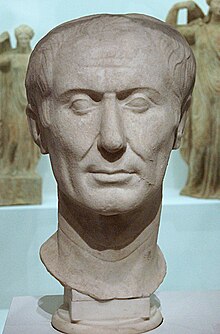
Summary
The Tusculum portrait, also called the Tusculum bust, is the only extant portrait of Julius Caesar which may have been made during his lifetime.[1] It is also one of the two accepted portraits of Caesar (alongside the Chiaramonti Caesar) which were made before the beginning of the Roman Empire.[2] Being one of the copies of the bronze original,[3] the bust has been dated to 50–40 BC and is housed in the permanent collection of the Museum of Antiquities in Turin, Italy.[4] Made of fine-grained marble, the bust measures 33 cm (1ft 1in) in height.

Description edit
The portrait's facial features are consistent with those found on coins struck shortly before Caesar's assassination, particularly on the denarii issued by Marcus Mettius.[3] The bust's head is prolonged, forming a saddle shape which could have been the result of a premature ossification of the sutures between the parietal bone and the temporal bone in Caesar's skull.[2] The portrait also exhibits dolichocephaly,[2] another type of cranial deformity which Caesar "may, or may not, have suffered"[5] from, according to Mary Beard. Like the Arles bust (which is also alleged to be a depiction of Caesar), the portrait includes a wrinkled neck, which could have been caused by years of campaigning in extreme weather conditions; this feature has been omitted from other posthumous busts, but can be seen on at least one coin issued during Caesar's lifetime.[6] According to Jiří Frel, this feature characterizes Caesar as a general rather than a ruler, unlike later busts.[7] The portrait's hair is present but thinning. These realistic features place the bust in the tradition of verism, as opposed to other surviving portraits which have been identified as Caesar.[8]
In modern day edit
The Tusculum portrait was excavated by Lucien Bonaparte at the forum in Tusculum in 1825 and was later brought to Castello d'Aglie, though it was not recognised as a bust of Caesar until Maurizio Borda identified it in 1940. The portrait was exhibited in the Louvre alongside the Arles bust. There are three known copies of the Tusculum portrait, which reside in Woburn Abbey and in private collections in Florence and Rome.[4][9]
See also edit
- Arles bust, possible third lifelike Caesar portrait.
References edit
- ^ Tom Stevenson (2014). Julius Caesar and the Transformation of the Roman Republic. Routledge. ISBN 978-1317597537.
- ^ a b c The J. Paul Getty Museum (1987). Ancient Portraits in the J. Paul Getty Museum: Volume 1. Getty Publications. p. 27. ISBN 0892360712.
- ^ a b Miriam Griffin, ed. (2009). A Companion to Julius Caesar. John Wiley & Sons. p. 302. ISBN 978-1444308457.
- ^ a b Amelia Carolina Sparavigna (2012). "Portraits of Julius Caesar: a proposal for 3D analysis". arXiv:1206.4866 [cs.CV].
- ^ Beard, Mary (2021). Twelve Caesars: Images of Power from the Ancient World to the Modern. Princeton: Princeton University Press. p. 60. ISBN 9780691222363.
- ^ "A New Honour: The Image of Caesar on Coins". Macquarie University. Macquarie University. 10 November 2014. Retrieved 26 January 2021.
- ^ Frel, Jiří (1977). "Caesar". The J. Paul Getty Museum Journal. 5: 55–62. ISSN 0362-1979. JSTOR 4166364.
- ^ Toynbee, J. M. C. (1957). "Portraits of Julius Caesar". Greece & Rome. 4 (1): 2–9. doi:10.1017/S0017383500015631. ISSN 0017-3835. JSTOR 641005.
- ^ Zanker, Paul (29 April 2009). "The Irritating Statues and Contradicting Portraits of Julius Caesar". In Miriam Griffin (ed.). A Companion to Julius Caesar. John Wiley & Sons. p. 302. ISBN 978-1-4443-0845-7.


